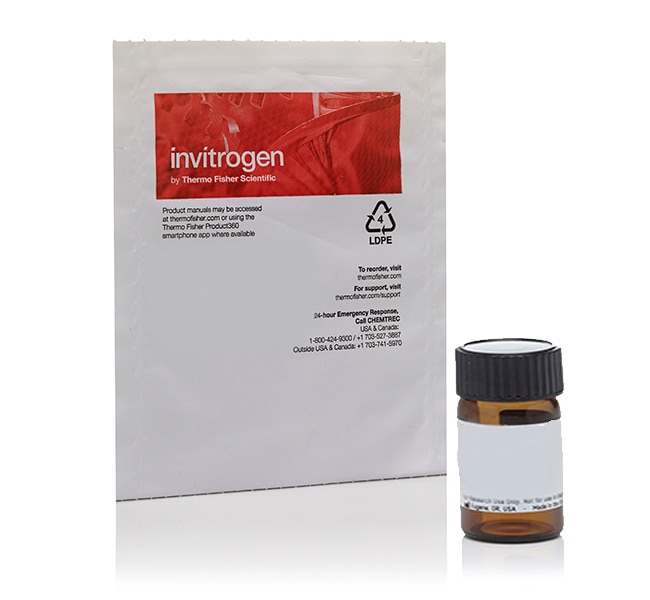Search Thermo Fisher Scientific

Certificates
SDS
Citations & References (48)
Invitrogen™
Carboxy-DCFDA (5-(and-6)-Carboxy-2',7'-Dichlorofluorescein Diacetate), mixed isomers
Carboxy-DCFDA can passively diffuse into cells and is colorless and nonfluorescent until the acetate groups are cleaved by intracellular esterasesRead more
| Catalog Number | Quantity |
|---|---|
| C369 | 100 mg |
Catalog number C369
Price (EUR)
522,00
Each
-
Quantity:
100 mg
Price (EUR)
522,00
Each
Carboxy-DCFDA can passively diffuse into cells and is colorless and nonfluorescent until the acetate groups are cleaved by intracellular esterases to yield the fluorescent fluorophore, 5-(and-6)-carboxy-2',7' -dichlorofluorescein. With a pKa of 4.8, this dye can be used as an acidic pH sensor.
To make a concentrated stock solution from 1–10 mM, dissolve in either high quality anhydrous DMSO, DMF, or 100% ethanol. Once prepared, use the stock solutions within a short time period.
Learn more about ion indicators including calcium, potassium, pH, and membrane potential indicators ›
For Research Use Only. Not for use in diagnostic procedures.
Specifications
Detection MethodFluorescence
Dye TypepH Indicator
Molecular Weight (g/mol)529.29
Quantity100 mg
Shipping ConditionRoom Temperature
For Use With (Application)Polar Tracer, pH Indicator
For Use With (Equipment)Fluorescence Microscope
Product TypeCarboxy-DCFDA
Unit SizeEach
Contents & Storage
Store in freezer (-5°C to -30°C).
Have questions about this product? Ask our AI assisted search.
Generating response
This is an AI-powered search and may not always get things right. You can help us make it better with a thumbs up or down on individual answers or by selecting the “Give feedback" button. Your search history and customer login information may be retained by Thermo Fisher and processed in accordance with our
Privacy Notice.
Figures

Chemical Structure
Customers who viewed this item also viewed
Documents & Downloads
Certificates
Search by lot number or partial lot number
Lot #Certificate TypeDateCatalog Number(s)
3135788Certificate of AnalysisApr 09, 2025C369
2930829Certificate of AnalysisMay 24, 2024C369
2500553Certificate of AnalysisJul 28, 2022C369
2379483Certificate of AnalysisSep 14, 2021C369
2282131Certificate of AnalysisMar 17, 2021C369
5 results displayed, search above for a specific certificate
Safety Data Sheets
SDS
Citations & References (48)
Search citations by name, author, journal title or abstract text
Citations & References
Abstract
Mitochondrial production of reactive oxygen species mediate dicumarol-induced cytotoxicity in cancer cells.
Journal:J Biol Chem
PubMed ID:17040906
'Dicumarol is a naturally occurring anticoagulant derived from coumarin that induces cytotoxicity and oxidative stress in human pancreatic cancer cells (Cullen, J. J., Hinkhouse, M. M., Grady, M., Gaut, A. W., Liu, J., Zhang, Y., Weydert, C. J. D., Domann, F. E., and Oberley, L. W. (2003) Cancer Res. 63,
Profilin 1 is essential for retention and metabolism of mouse hematopoietic stem cells in bone marrow.
Journal:
PubMed ID:24385538
'How stem cells interact with the microenvironment to regulate their cell fates and metabolism is largely unknown. Here we demonstrated that the deletion of the cytoskeleton-modulating protein profilin 1 (pfn1) in hematopoietic stem cell (HSCs) led to bone marrow failure, loss of quiescence, and mobilization and apoptosis of HSCs in
KEAP1 is a redox sensitive target that arbitrates the opposing radiosensitive effects of parthenolide in normal and cancer cells.
Journal:
PubMed ID:23674500
'Elevated oxidative stress is observed more frequently in cancer cells than in normal cells. It is therefore expected that additional exposure to a low level of reactive oxygen species (ROS) will push cancer cells toward death, whereas normal cells might maintain redox homeostasis through adaptive antioxidant responses. We previously showed
G-protein ligands inhibit in vitro reactions of vacuole inheritance.
Journal:J Cell Biol
PubMed ID:8027189
'During budding in Saccharomyces cerevisiae, maternal vacuole material is delivered into the growing daughter cell via tubular or vesicular structures. One of the late steps in vacuole inheritance is the fusion in the bud of vesicles derived from the maternal vacuole. This process has been reconstituted in vitro and requires
A trace amount of the human pro-apoptotic factor Bax induces bacterial death accompanied by damage of DNA.
Journal:J Biol Chem
PubMed ID:9556634
'An amount of human pro-apoptotic Bax as low as 0.01% of total protein was sufficient to cause cell death in Escherichia coli. The bacterial cell death was examined using a viable bacteria-specific fluorescence indicator system and loss of colony formation ability. Co-expression of anti-apoptotic Bcl-xL showed a modest inhibitory effect
48 total citations
